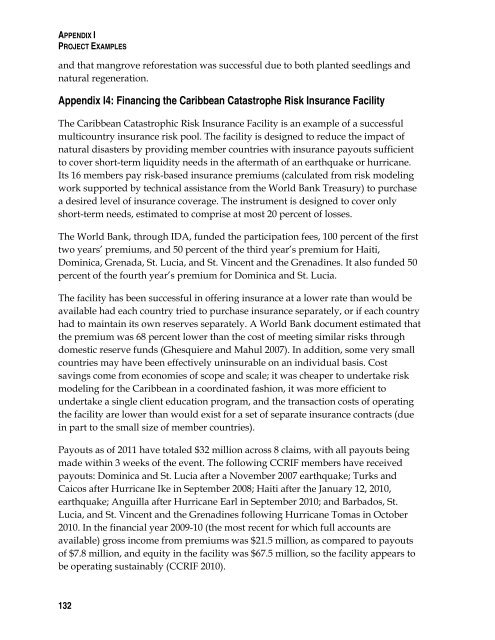Adapting to Climate Change: Assessing the World Bank Group ...
Adapting to Climate Change: Assessing the World Bank Group ...
Adapting to Climate Change: Assessing the World Bank Group ...
You also want an ePaper? Increase the reach of your titles
YUMPU automatically turns print PDFs into web optimized ePapers that Google loves.
APPENDIX IPROJECT EXAMPLESand that mangrove reforestation was successful due <strong>to</strong> both planted seedlings andnatural regeneration.Appendix I4: Financing <strong>the</strong> Caribbean Catastrophe Risk Insurance FacilityThe Caribbean Catastrophic Risk Insurance Facility is an example of a successfulmulticountry insurance risk pool. The facility is designed <strong>to</strong> reduce <strong>the</strong> impact ofnatural disasters by providing member countries with insurance payouts sufficient<strong>to</strong> cover short-term liquidity needs in <strong>the</strong> aftermath of an earthquake or hurricane.Its 16 members pay risk-based insurance premiums (calculated from risk modelingwork supported by technical assistance from <strong>the</strong> <strong>World</strong> <strong>Bank</strong> Treasury) <strong>to</strong> purchasea desired level of insurance coverage. The instrument is designed <strong>to</strong> cover onlyshort-term needs, estimated <strong>to</strong> comprise at most 20 percent of losses.The <strong>World</strong> <strong>Bank</strong>, through IDA, funded <strong>the</strong> participation fees, 100 percent of <strong>the</strong> firsttwo years’ premiums, and 50 percent of <strong>the</strong> third year’s premium for Haiti,Dominica, Grenada, St. Lucia, and St. Vincent and <strong>the</strong> Grenadines. It also funded 50percent of <strong>the</strong> fourth year’s premium for Dominica and St. Lucia.The facility has been successful in offering insurance at a lower rate than would beavailable had each country tried <strong>to</strong> purchase insurance separately, or if each countryhad <strong>to</strong> maintain its own reserves separately. A <strong>World</strong> <strong>Bank</strong> document estimated that<strong>the</strong> premium was 68 percent lower than <strong>the</strong> cost of meeting similar risks throughdomestic reserve funds (Ghesquiere and Mahul 2007). In addition, some very smallcountries may have been effectively uninsurable on an individual basis. Costsavings come from economies of scope and scale; it was cheaper <strong>to</strong> undertake riskmodeling for <strong>the</strong> Caribbean in a coordinated fashion, it was more efficient <strong>to</strong>undertake a single client education program, and <strong>the</strong> transaction costs of operating<strong>the</strong> facility are lower than would exist for a set of separate insurance contracts (duein part <strong>to</strong> <strong>the</strong> small size of member countries).Payouts as of 2011 have <strong>to</strong>taled $32 million across 8 claims, with all payouts beingmade within 3 weeks of <strong>the</strong> event. The following CCRIF members have receivedpayouts: Dominica and St. Lucia after a November 2007 earthquake; Turks andCaicos after Hurricane Ike in September 2008; Haiti after <strong>the</strong> January 12, 2010,earthquake; Anguilla after Hurricane Earl in September 2010; and Barbados, St.Lucia, and St. Vincent and <strong>the</strong> Grenadines following Hurricane Tomas in Oc<strong>to</strong>ber2010. In <strong>the</strong> financial year 2009-10 (<strong>the</strong> most recent for which full accounts areavailable) gross income from premiums was $21.5 million, as compared <strong>to</strong> payoutsof $7.8 million, and equity in <strong>the</strong> facility was $67.5 million, so <strong>the</strong> facility appears <strong>to</strong>be operating sustainably (CCRIF 2010).132

















